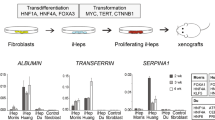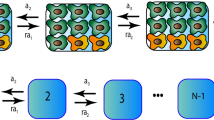Abstract
CELL proliferation has often been implicated in the development of cancer with chemicals1–3. Supportive evidence for this is the observation that several carcinogens that normally do not induce liver cancer in intact adult animals, especially with a single dose, become carcinogenic if administered as a single injection after partial hepatectomy (PH)1. In these conditions, it is thought that PH may act during initiation, presumably by fixation of some carcinogen-induced DNA damage through replication of the altered DNA. However, because carcinogenesis is a multi-step process, often involving the appearance of several new cell populations between the initial target cells and the ultimate cancer4,5, it is possible that the regenerative response of liver following PH could have a major effect on one or more steps subsequent to initiation. Thus, the use of a very late end-point (cancer) makes it difficult, if not impossible, to relate with any accuracy some very early event to any specific step in the carcinogenic process. Solt and Farber6 have recently developed a new approach to the sequential analysis of carcinogenesis in vivo that delineates the first few steps in the process and is a quantitative assay for initiation of liver cancer. We have used this model to investigate whether cell replication exerts its first effect on initiation or on some later step in the carcinogenic process. And if initiation is at least one site of action, when in the regenerative cell cycle is a carcinogen most effective and what biochemical events might be involved at this phase of the cell cycle?
This is a preview of subscription content, access via your institution
Access options
Subscribe to this journal
Receive 51 print issues and online access
$199.00 per year
only $3.90 per issue
Buy this article
- Purchase on Springer Link
- Instant access to full article PDF
Prices may be subject to local taxes which are calculated during checkout
Similar content being viewed by others
References
Craddock, V. M. in Liver Cell Cancer (eds Cameron, H. M., Linsell, D. S. & Warwick, G. P.) 153–201 (Elsevier, Amsterdam, 1976).
Rajewsky, M. F. Z. Krebsforsch. 78, 12–30 (1972).
Warwick, G. P. Fedn Proc. 30, 1760–1765 (1971).
Foulds, L. Neoplastic Development 1, Ch. 3 (Academic, London, 1969).
Farber, E. Cancer Res. 33, 2537–2550 (1973).
Solt, D. & Farber, E. Nature 263, 701–703 (1976).
Solt, D., Medline, A. & Farber, E. Am. J. Path. 88, 595–610 (1977).
Cameron, R., Kellen, J., Kolin, A., Malkin, A. & Farber, E. Cancer Res. 38, 823–829 (1978).
Fiala, S., Fiala, A. E. & Dixon, B. J. natn. Cancer Inst. 48, 1393–1401 (1972).
Kalengayi, M. M. R., Ronchi, G. & Desmet, V. J. J. natn. Cancer Inst. 55, 579–588 (1975).
Swann, P. F. & Magee, P. N. Biochem. J. 110, 39–47 (1968).
Craddock, V. M. & Frei, J. V. Br. J. Cancer 30, 503–511 (1974).
Schulte-Hermann, R. Cancer Res. 37, 166–171 (1977).
Kaufman, D. G., Kaufman, W. K., Rice, J. M. & Wenk, M. L. Proc. Am. Ass. Cancer Res. 19, 183 (1978).
Rajalakshmi, S. & Sarma, D. S. R. Chem.-Biol. Interactions 11, 245–252 (1975).
Abanobi, S. E., Mulivor, R. A., Rajalakshmi, S. & Sarma, D. S. R. Proc. Am. Ass. Cancer Res. 17, 103 (1976).
Zahner, A. J., Rajalakshmi, S. & Sarma, D. S. R. Proc. Am. Ass. Cancer Res. 18, 19 (1977).
Rutenburg, A. M. et al. J. Histochem. Cytochem. 17, 517–526 (1969).
Borek, C. & Sachs, L. Proc. natn. Acad. Sci. U.S.A. 57, 1522–1527 (1967).
Borek, C. & Sachs, L. Proc. natn. Acad. Sci. U.S.A. 59, 83–85 (1968).
Todaro, G. J. & Green, H. Proc. natn. Acad. Sci. U.S.A. 55, 302–308 (1966).
Mondal, S. & Heilderberger, C. Proc. natn. Acad. Sci. U.S.A. 65, 219–225 (1970).
Author information
Authors and Affiliations
Rights and permissions
About this article
Cite this article
CAYAMA, E., TSUDA, H., SARMA, D. et al. Initiation of chemical carcinogenesis requires cell proliferation. Nature 275, 60–62 (1978). https://doi.org/10.1038/275060a0
Received:
Accepted:
Issue Date:
DOI: https://doi.org/10.1038/275060a0
This article is cited by
-
Biochemical and histopathological studies of sulfonylurea derivative as a new chemotherapeutic agent against liver cancer in free- and nano-coated forms
Applied Biological Chemistry (2022)
-
Comparison of DNA adduct formation between 2,4 and 2,6-dinitrotoluene by32P-postlabelling analysis
Archives of Toxicology (1992)
-
Single cell analysis in toxicity testing: the mitogenic activity of thioacetamide in cultured rat hepatocytes analyzed by DNA/protein flow cytometry
Archives of Toxicology (1991)
Comments
By submitting a comment you agree to abide by our Terms and Community Guidelines. If you find something abusive or that does not comply with our terms or guidelines please flag it as inappropriate.



